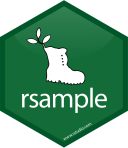library(tidymodels)
library(forested)
forested
#> # A tibble: 7,107 × 19
#> forested year elevation eastness northness roughness tree_no_tree dew_temp
#> <fct> <dbl> <dbl> <dbl> <dbl> <dbl> <fct> <dbl>
#> 1 Yes 2005 881 90 43 63 Tree 0.04
#> 2 Yes 2005 113 -25 96 30 Tree 6.4
#> 3 No 2005 164 -84 53 13 Tree 6.06
#> 4 Yes 2005 299 93 34 6 No tree 4.43
#> 5 Yes 2005 806 47 -88 35 Tree 1.06
#> 6 Yes 2005 736 -27 -96 53 Tree 1.35
#> 7 Yes 2005 636 -48 87 3 No tree 1.42
#> 8 Yes 2005 224 -65 -75 9 Tree 6.39
#> 9 Yes 2005 52 -62 78 42 Tree 6.5
#> 10 Yes 2005 2240 -67 -74 99 No tree -5.63
#> # ℹ 7,097 more rows
#> # ℹ 11 more variables: precip_annual <dbl>, temp_annual_mean <dbl>,
#> # temp_annual_min <dbl>, temp_annual_max <dbl>, temp_january_min <dbl>,
#> # vapor_min <dbl>, vapor_max <dbl>, canopy_cover <dbl>, lon <dbl>, lat <dbl>,
#> # land_type <fct>2 - Your data budget
Introduction to tidymodels
Data on forests in Washington
- The U.S. Forest Service maintains ML models to predict whether a plot of land is “forested.”
- This classification is important for all sorts of research, legislation, and land management purposes.
- Plots are typically remeasured every 10 years and this dataset contains the most recent measurement per plot.
- Type
?forestedto learn more about this dataset, including references.
Data on forests in Washington
N = 7,107plots of land, one from each of 7,107 6000-acre hexagons in WA.- A nominal outcome,
forested, with levels"Yes"and"No", measured “on-the-ground.” - 18 remotely-sensed and easily-accessible predictors:
- numeric variables based on weather and topography.
- nominal variables based on classifications from other governmental orgs.
Checklist for predictors
Is it ethical to use this variable? (Or even legal?)
Will this variable be available at prediction time?
Does this variable contribute to explainability?
Data on forests in Washington
Data splitting and spending
For machine learning, we typically split data into training and test sets:
- The training set is used to estimate model parameters.
- The test set is used to find an independent assessment of model performance.
Do not 🚫 use the test set during training.
Data splitting and spending
The more data
we spend 🤑
the better estimates
we’ll get.
Data splitting and spending
- Spending too much data in training prevents us from computing a good assessment of predictive performance.
- Spending too much data in testing prevents us from computing a good estimate of model parameters.
Your turn

When is a good time to split your data?
03:00
The testing data is precious 💎
The initial split ![]()
What is set.seed()?
To create that split of the data, R generates “pseudo-random” numbers: while they are made to behave like random numbers, their generation is deterministic given a “seed”.
This allows us to reproduce results by setting that seed.
Which seed you pick doesn’t matter, as long as you don’t try a bunch of seeds and pick the one that gives you the best performance.
Accessing the data ![]()
The training set![]()
forested_train
#> # A tibble: 5,330 × 19
#> forested year elevation eastness northness roughness tree_no_tree dew_temp
#> <fct> <dbl> <dbl> <dbl> <dbl> <dbl> <fct> <dbl>
#> 1 No 2016 464 -5 -99 7 No tree 1.71
#> 2 Yes 2016 166 92 37 7 Tree 6
#> 3 No 2016 644 -85 -52 24 No tree 0.67
#> 4 Yes 2014 1285 4 99 79 Tree 1.91
#> 5 Yes 2013 822 87 48 68 Tree 1.95
#> 6 Yes 2017 3 6 -99 5 Tree 7.93
#> 7 Yes 2014 2041 -95 28 49 Tree -4.22
#> 8 Yes 2015 1009 -8 99 72 Tree 1.72
#> 9 No 2017 436 -98 19 10 No tree 1.8
#> 10 No 2018 775 63 76 103 No tree 0.62
#> # ℹ 5,320 more rows
#> # ℹ 11 more variables: precip_annual <dbl>, temp_annual_mean <dbl>,
#> # temp_annual_min <dbl>, temp_annual_max <dbl>, temp_january_min <dbl>,
#> # vapor_min <dbl>, vapor_max <dbl>, canopy_cover <dbl>, lon <dbl>, lat <dbl>,
#> # land_type <fct>The test set ![]()
🙈
There are 1777 rows and 19 columns in the test set.
Your turn

Split your data so 20% is held out for the test set.
Try out different values in set.seed() to see how the results change.
05:00
Data splitting and spending ![]()
Exploratory data analysis for ML 🧐
Your turn

Explore the forested_train data on your own!
- What’s the distribution of the outcome,
forested? - What’s the distribution of numeric variables like
precip_annual? - How does the distribution of
foresteddiffer across the categorical variables?
08:00
The whole game - status update

